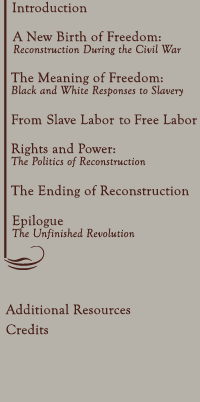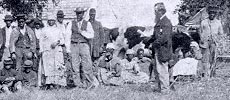








A
New Birth of Freedom:
Reconstruction During the Civil War

The
Civil War, in the words of President Abraham Lincoln, brought to America
"a new birth of freedom." And during the war began the nation's
efforts to come to terms with the destruction of slavery and to define
the meaning of freedom.
By the war's end it was already clear that Reconstruction would bring
far-reaching changes in Southern society, and a redefinition of the
place of blacks in American life.
 |
The
Civil War did not begin as a total war, but it soon became one:
a struggle that pitted society against society. Never before had mass armies confronted each other on the battlefield with the deadly weapons created by the industrial revolution. |
The resulting casualties dwarfed anything in the American experience. Some 650,000 men died in the war, including 260,000 Confederates -- over one-fifth of the South's adult white male population.
 |
At the war's outset, the Lincoln administration insisted that restoring the Union was its only purpose. But as slaves by the thousands abandoned the plantations and headed for Union lines, and military victory eluded the North, the president made the destruction of slavery a war aim -- a decision announced in the Emancipation Proclamation of January 1863. |
The Proclamation also authorized the enlistment of black soldiers.
By the end of the Civil War, some 200,000 black soldiers had served in the Union army and navy, staking a claim to citizenship in the postwar nation.
| During
the war, "rehearsals for Reconstruction" took place in
the Union-occupied South. On the South Carolina Sea Islands, the former slaves demanded land of their own, while government officials and Northern investors urged them to return to work on the plantations. |
 |
In addition, a group of young Northern reformers came to the islands to educate the freedpeople and assist in the transition from slavery to freedom. The conflicts among these groups offered a preview of the national debate over Reconstruction.
Copyright
2003